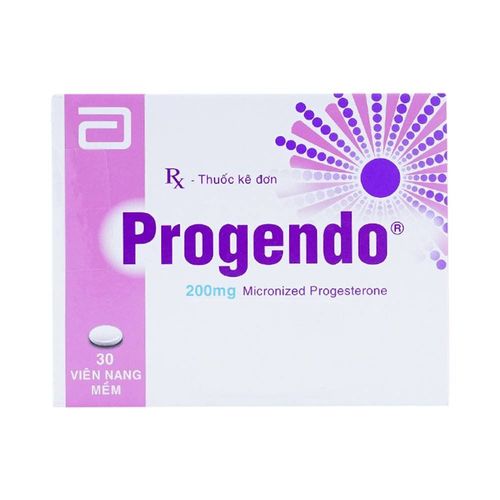This is an automatically translated article.
The article is professionally consulted by Master, Doctor Trinh Thi Thanh Huyen - Department of Obstetrics and Gynecology - Vinmec Hai Phong International General Hospital.
Endometrial cancer is cancer that begins in the lining of the uterus. The disease is curable and the success rate after surgery is much higher than other cancers.
1. What is endometrial cancer?
Endometrial cancer is a primary malignant epithelial tumor from the endometrial epithelium, often glandular differentiation, it has the ability to invade the muscular layer and spread to distant sites. Endometrial cancer ranks 6th among cancers in women and 2nd in gynecological cancers.2. Risk factors for endometrial cancer
Endocrine factors: Prolonged hyperestrogenism, ovulation disorders, polycystic ovary syndrome, early puberty, late menopause. Genetic factors: There is a family history of endometrial cancer, breast cancer, colon cancer (Lynch syndrome) Condition: obesity, high blood pressure, diabetes Diet high in animal fat Use Tamoxifen.
Béo phì là một trong những nguyên nhân gây ung thư niêm mạc tử cung
3. Diagnosis of endometrial cancer
3.1 Clinical diagnosis
Abnormal vaginal bleeding: in pre-menopausal women, there are signs of menstrual disorders, menorrhagia, heavy bleeding, menopausal women have abnormal vaginal bleeding, this symptom is very common, accounting for many years. up to 80% of cases. Vaginal foul discharge: discharge is usually due to infection, blood and necrotic substances cause foul odor, this manifestation is present in about 30% of patients The disease progresses in the late stage: the patient presents with pain due to invasion, compression, hematuria, ascites,.. Physical symptoms when the doctor examines the vagina by hand and speculum: in the early stages, the uterus usually changes less in size and density. In the late stage, the uterus is invasive, sticky, less mobile, invading the peritoneum, vagina, rectum,...3.2 Laboratory tests
Ultrasound: Transvaginal ultrasound helps evaluate the thickness and structure of the uterine lining, the extent of invasion into the uterine muscle, excluding other pelvic pathologies; General abdominal ultrasound to document the spread and metastasis of the disease. Endometrial biopsy: this is a mandatory requirement in the diagnosis of endometrial cancer, in order to evaluate whether the lesion is benign or malignant and the histology, histopathological type, and primary endometrial cancer. uterus or cervix. Hysteroscopy: this test allows to see the lesion and determine the extent of surface spread and orient the biopsy to the right location of the lesion. Computed tomography (CT scan), abdominal magnetic resonance imaging (MRI) and PET CT: help evaluate the extent of invasion, tumor spread, lymph node metastasis. Other tests: chest x-ray to detect lung metastases, biomarker CA125 increased in about 50-60% of cases, beta hCG to rule out intrauterine pregnancy, bone scan if metastases are suspected bone, UIV, cystoscopy, rectal examination if the tumor is suspected to invade these organs.4. Classification of disease stages according to FIGO 2009
Stage I: tumor is localized to the body of the uterus IA: tumor is localized to the endometrium or invade <1⁄2 of myometrial thickness IB: invasive tumor is >=1⁄2 of myometrial thickness. Stage II: Tumor has spread to the cervical stroma Stage III: Tumor has spread locally or in the region IIIA: Tumor invades the serosa or its appendages IIIB: Tumor invades the vagina and/or uterus IIIC: metastasis pelvic or para-aortic lymph node metastasis Stage IV: tumor invading the pelvis or distant metastasis IVA: tumor invading bladder or rectal mucosa IVB: distant metastasis (inguinal, lung, liver, bone lymph nodes) , abdominal peritoneum,...)5. Methods of treatment for endometrial cancer
The treatment methods for endometrial cancer include:Surgical treatment: Surgery is the first priority measure in the treatment of endometrial cancer. There are two surgical methods: laparotomy and laparoscopy. Depending on the case, the indications are total hysterectomy, double appendectomy, or extensive hysterectomy with lymph node dissection, removal of the greater omentum, transabdominal hysterectomy should be performed to clearly observe the associated lesions. . Radiation therapy: This is the second most effective treatment for endometrial cancer. Radiation therapy is indicated for late stage cancer or adjuvant treatment after surgery Endocrine therapy in case of late stage. Chemotherapy: Less effective, only used in relapse in young women. The choice and combination of treatment methods depends on the specific disease stage of each patient.
Stage 1: The doctor appoints a complete hysterectomy, bilateral appendages and removal of pelvic and parathyroid lymph nodes. aorta. Accordingly, adjuvant radiation therapy when there are poor prognostic factors (histological grade 2 or 3, or invasion of more than 1⁄2 muscle layer depth). If in the case of endometrial cancer has spread down the cervical canal and infiltrated, then Wertheim surgery must be performed. Stage 2: Complete hysterectomy, two appendages and lymph node removal. After 4-6 weeks of radiation. If in the case of large cervical lesions, then radiation before, 4-6 weeks after surgery. Stage 3: Surgery and radiation are still the mainstays of treatment. If surgery is possible, complete hysterectomy and radiation therapy, otherwise localized radium needle radiation and hormonal chemotherapy. Stage 4: People with late-stage disease or recurrence in distant locations can be treated with radiation to prevent pain, bleeding and compression. Combined endocrine therapy. After treatment, patients need to be followed up every 3 months for the first 2 years, every 6 months for the next 2 years and then once a year.

Những phụ nữ trên 40 tuổi dễ mắc bệnh nên cần được xét nghiệm tế bào phụ khoa để phòng bệnh
To prevent disease, women > 40 years old, if gynecological examination has clusters of endometrial glands, need to have the uterus aspirated to perform histopathological examination, menopausal women have signs of abnormal bleeding. need to go for ultrasound to evaluate endometrial thickness, hysteroscopy and take samples for histopathology, especially in obese patients or with a history of Tamoxifen treatment. The examination and detection of the disease at an early stage helps to increase the effectiveness of treatment and the survival of the patient.
Endometrial cancer is a common disease in women over 50 years old, the disease can be cured if detected and treated at an early stage. Therefore, women over 40 years old should have regular gynecological health check-ups to detect gynecological diseases in the perimenopausal age.
Master. Trinh Thi Thanh Huyen is highly trained in obstetric ultrasound, laparoscopic surgery and hysteroscopy at the National Hospital of Obstetrics and Gynecology and has more than 13 years of experience working at Hai Phong Obstetrics and Gynecology Hospital.
Currently, the doctor is an Obstetrician and Gynecologist at Vinmec Hai Phong International General Hospital
Please dial HOTLINE for more information or register for an appointment HERE. Download MyVinmec app to make appointments faster and to manage your bookings easily.













